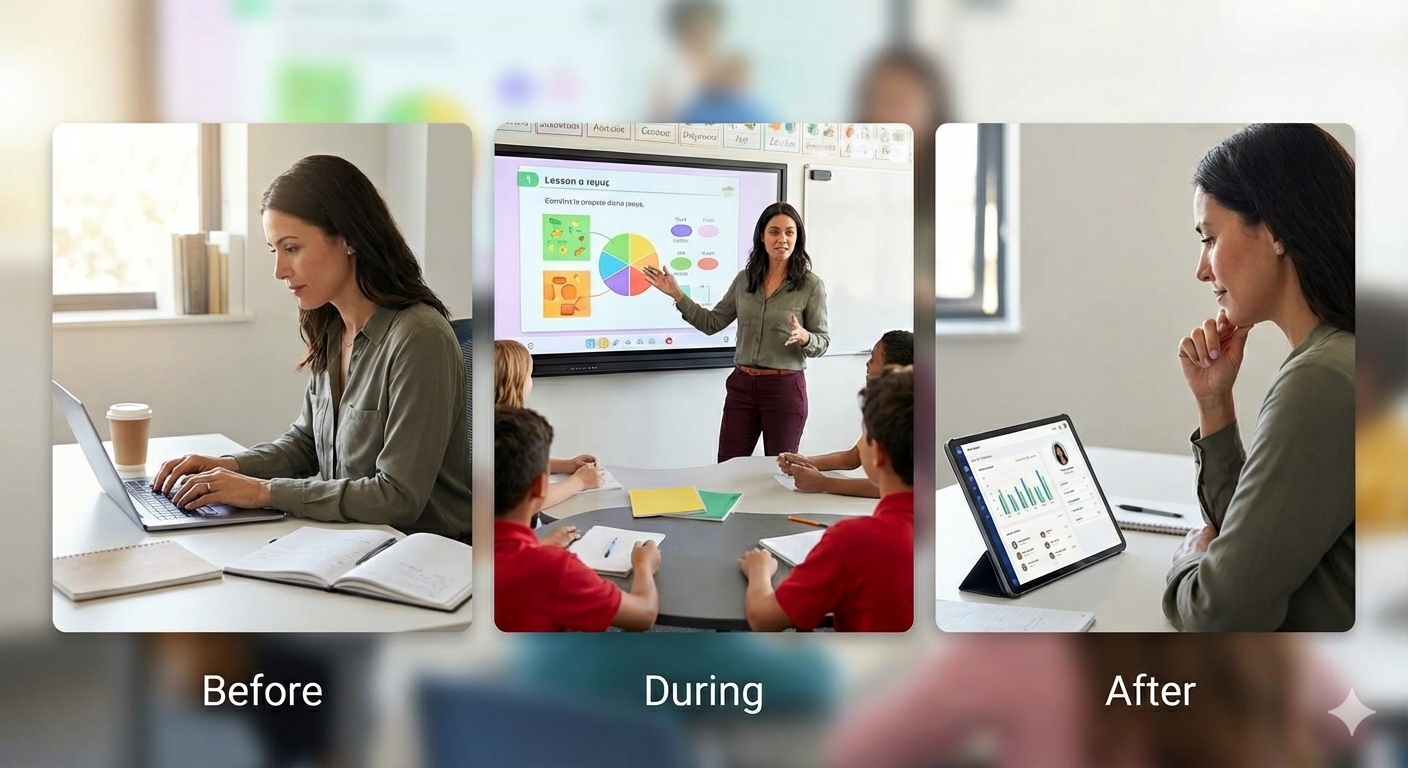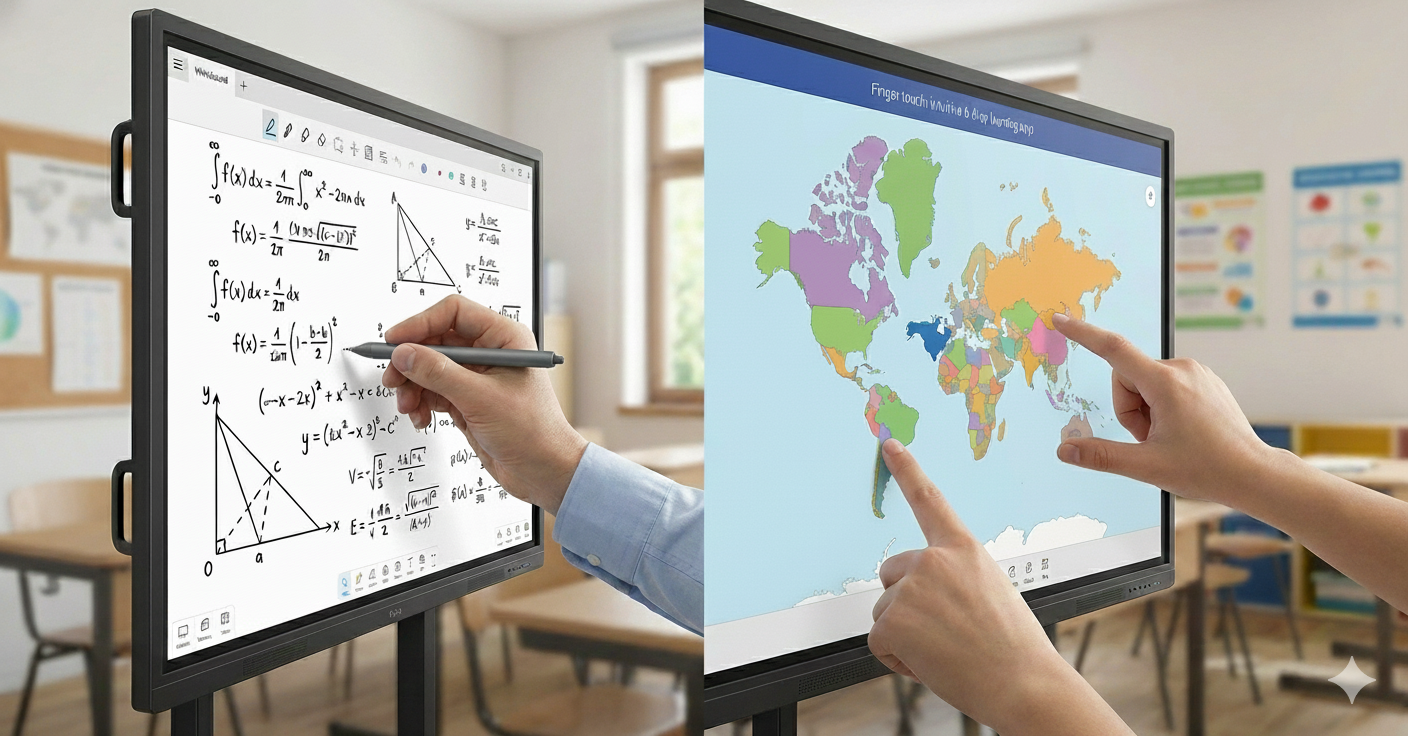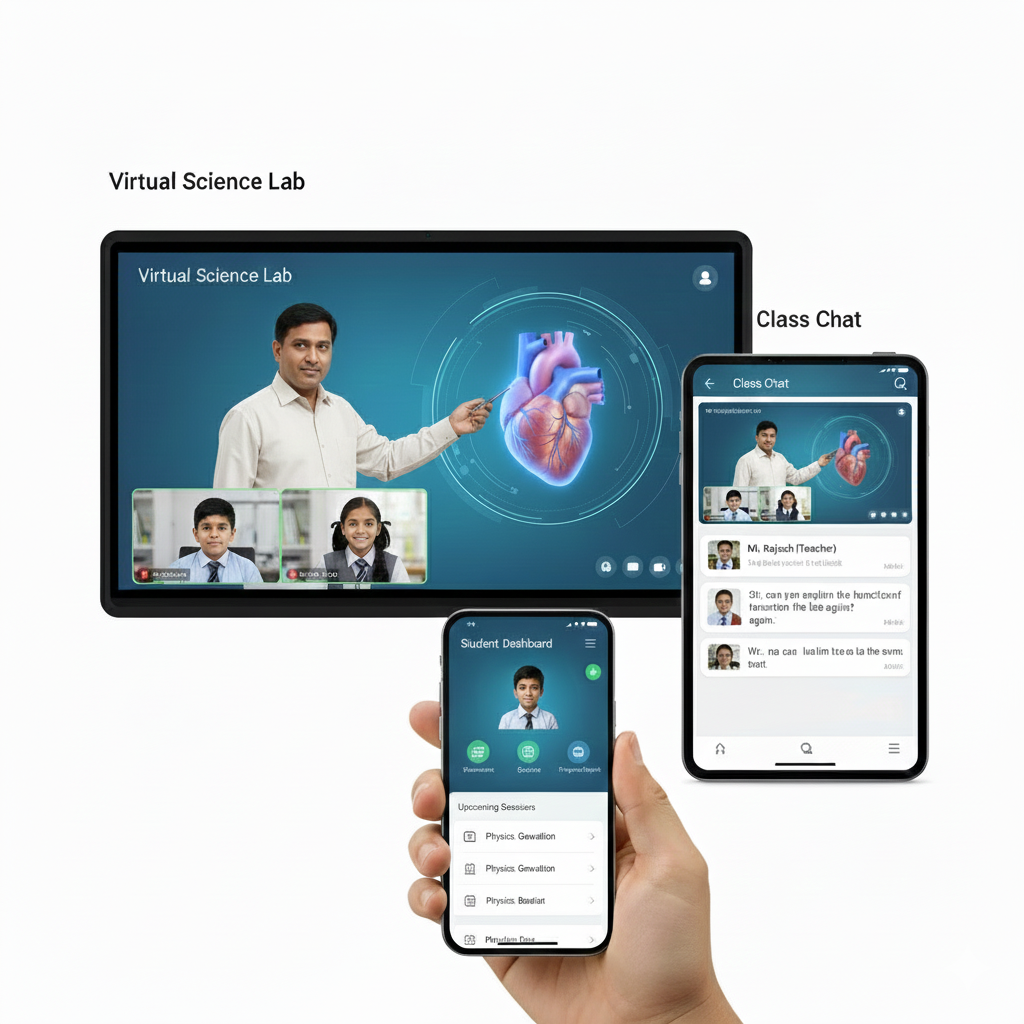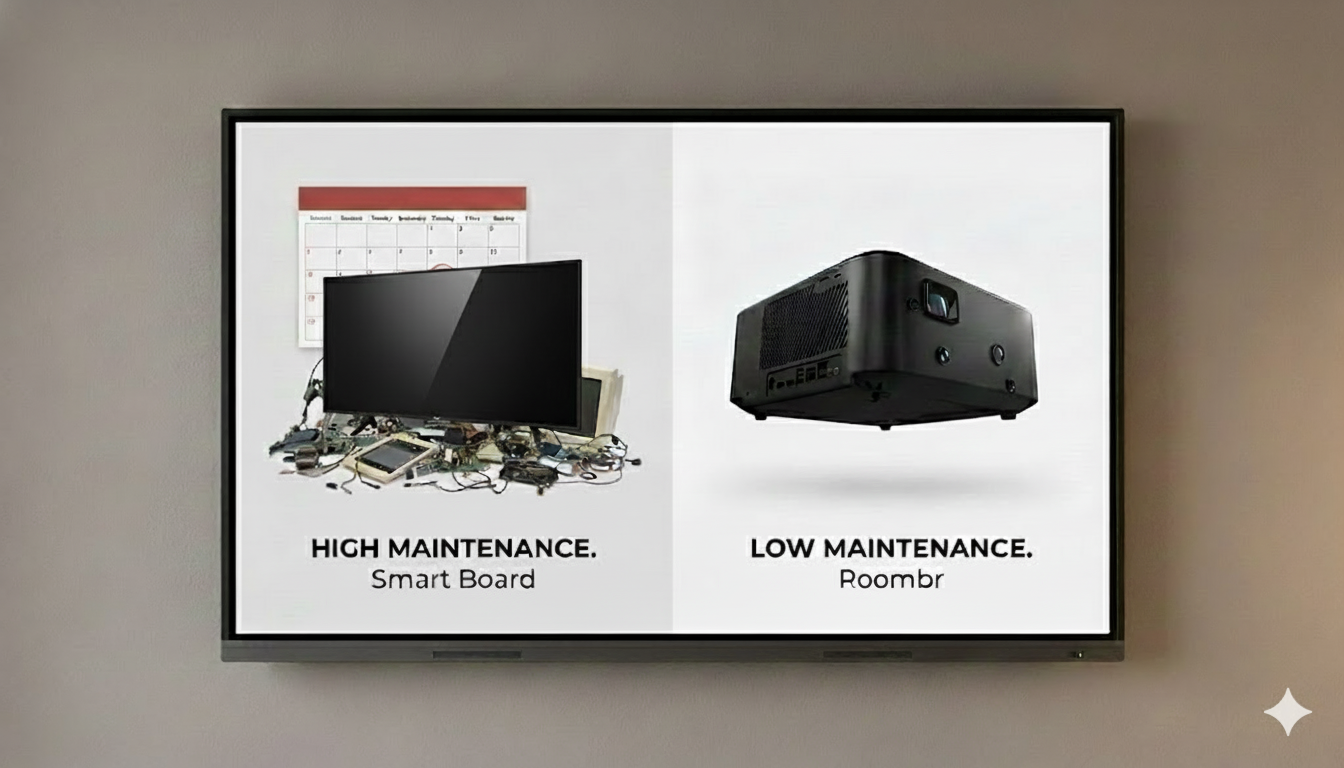Modern Digital Classroom vs. Traditional Classroom: A Comparative Analysis
.jpeg)
Education is at a pivotal moment, with classrooms evolving more rapidly than ever before. Most of us have experienced traditional classrooms—the chalkboard, the projector that never quite works when you need it, and those clunky textbooks that practically require a trolley to carry around. Today, however, we’re talking about something far more powerful, interactive, and efficient: the modern digital classroom.
When we say digital classroom, we are not talking about simply putting a smart board on the wall and calling it a day. We’re talking about a complete transformation—integrating digital classroom setups that enhance teaching and make learning engaging and efficient. It’s a classroom where students can collaborate digitally, work in real-time with peers miles away, and where teachers can teach a hybrid class—both online and offline simultaneously—with just the tap of a button.
And that’s just the beginning.
In this comparative guide, we’ll examine the key differences between traditional and modern digital classrooms. As an educator, you will gain insights into how digital technology is reshaping education, why it represents the future of teaching and learning, and how implementing it can significantly enhance instructional delivery and student engagement in your institution.

The Traditional Classroom – Tried, Tested, but Tired
Let’s start by revisiting what we all know well: the traditional classroom. For centuries, this model has been the backbone of education. We’ve got desks in neat rows, a teacher standing at the front with a piece of chalk or a marker, and a textbook that’s been in circulation for a decade. It’s a comfortable setting—predictable, even. But the question remains: Is it still the most effective way to teach and learn in today’s fast-paced, tech-driven world?
Core Challenges of a Traditional Teaching Model
Traditional classrooms come with their own set of limitations:
- One-Size-Fits-All Learning: Every student has different needs and learning speeds, yet traditional classrooms often don’t allow for that flexibility.
- Limited Resources: Teaching materials are often confined to whatever’s in the textbook or on the board. When students miss a class, they lose the opportunity to engage with that day’s lesson.
- Engagement Challenges: Let’s be honest—keeping students engaged with just a textbook and a lecture can sometimes feel like pulling teeth. With their attention spans getting shorter by the day, traditional teaching methods are increasingly becoming ineffective.
In short, traditional classrooms are not equipped to handle the dynamic needs of today’s students. But the good news? We have solutions!
The Modern Digital Classroom: A Smart, Scalable Shift
This isn’t just about using technology; it’s about creating an interactive, immersive, and personalized learning environment that meets the demands of both teachers and students.
The key to this transformation lies in a well-designed digital classroom setup. And here’s the kicker—it’s not just about fancy gadgets. It’s about revolutionizing how students learn and how teachers teach. Here’s why it offers a significant advantage over the traditional model:
- Accessibility & Flexibility:
With an AI-powered interactive classroom setup, learning becomes flexible. Students can join in from anywhere. Sick? No problem. Traveling? It's okay, too. With recorded lessons and digital content, students can access their lessons anytime, from anywhere, right from their own devices.
- Blending Online and Offline:
One of the standout features is the ability to teach a hybrid class. Imagine teaching students in the room while simultaneously streaming the lesson live to remote learners. It’s the best of both worlds! The interactive projector allows for seamless integration between physical and digital learning environments.
- Smooth Digital Collaboration:
Collaboration has never been easier. Students can work on shared projects in real-time, no matter where they are. Whether it’s a group presentation or a brainstorming session, digital collaboration in the classroom brings people together in ways the traditional classroom never could. Forget the physical barriers; we’re now working in the cloud.
- Personalized Learning:
With digital classrooms, no student is left behind. Teachers can offer differentiated instruction, personalized to each student's learning pace and style. Adaptive learning technologies make it possible to tailor lessons to suit individual needs. The classroom becomes a personalized learning environment rather than a one-size-fits-all setup.
Top Benefits of Interactive Projectors in a Digital Classroom
When you think of a smart classroom, the first thing that should come to mind is interactive technology. Gone are the days of static chalkboards. Today, we have interactive projectors that extend from a mere 120 inches to a massive 200 inches in glorious HD. These projectors don’t just display images—they engage with them.

Here’s how the interactive projector changes the game:
- Multi-Functional Capabilities: Teachers can annotate, highlight, and engage directly with the content projected on the screen, making lessons far more dynamic.
- Recording Lessons: The dual-camera setup allows teachers to record lessons. Students who missed class can access these recordings whenever they need to. It’s like having a classroom in your pocket.
- 3D Learning: These setups are equipped with 3D capabilities, making science classes, architecture lessons, and even art much more immersive and hands-on.
This is technology that doesn’t just make life easier for teachers—it enhances the entire educational experience for students. Whether they’re in the classroom or at home, students will have access to the best possible learning tools.
Thinking of upgrading? See how Roombr’s AI-powered classroom solutions work in real classrooms.
Teacher-Centric, Not Tech-Centric
Here’s something that often gets misunderstood. People hear about digital classrooms and think it’s all about technology replacing teachers. That couldn’t be further from the truth. The modern AI-powered classroom is still very much teacher-centric. The technology is there to empower teachers, not replace them. These interactive tools allow teachers to focus on what matters– engaging with students, facilitating discussion, and ensuring every student understands the material. You don't need any technical expertise to use them. The interface is intuitive, easy to navigate, and designed to make teachers’ lives easier.
Why It’s Crucial For Educational Institutions to Make the Switch?
We’re not just talking about enhancing classrooms; we’re talking about keeping up with the future. The world is becoming increasingly digital, and education must follow suit. Here are the cold, hard facts:
- Future-Ready Students: Students need digital literacy to succeed in the world they’ll enter after school. Integrating technology into the classroom helps equip students with the skills needed for the future workforce.
- Global Collaboration: Today’s students will be working in a global environment. Digital classrooms make it easier for them to collaborate with peers and professionals around the world, enhancing their global perspective.
- Engagement & Retention: With digital tools like interactive projectors and 3D content, engagement skyrockets. When students are fully involved, they remember information better. It’s a win-win.
By not making the shift to a digital classroom setup, we risk leaving our students behind. The traditional model has served its purpose, but the future demands something more interactive, more flexible, and more immersive.
Quick Comparison: Traditional vs. Digital Classroom
Common Misconceptions: It’s Not About the Gadgets
A common misconception is that digital classroom equipment is expensive and difficult to maintain. While the initial setup may seem like an investment, think of the long-term benefits:
- Cost-Efficiency: Over time, a smart classroom reduces the need for physical resources. No more buying new textbooks every year. No more paper handouts. Everything becomes digital.
- Ease of Use: Modern classrooms are designed to be user-friendly. You don’t need to be a tech genius to operate them. Most teachers can get the hang of it in just a few training sessions.
- Ongoing Support: With modern setups, tech support is just a call away. Issues are resolved quickly, and there’s constant innovation to make the technology more efficient.
Here’s a quick guide to affordable digital classroom hardware that helps you decide what to buy and what to skip.

Conclusion
The goal here isn’t to make teaching harder or more complicated. On the contrary, a modern digital classroom is all about making education more accessible, engaging, and effective for both students and teachers. It’s about preparing our students for a future where digital literacy will be as important as reading and writing. By making the switch, we’re not just upgrading our classrooms—we’re upgrading our entire approach to education. This is how we prepare our students for the challenges of tomorrow, how we ensure they are ready to succeed in an increasingly digital world, and how we, as educators, stay at the forefront of innovation.
Frequently Asked Questions By Educators
1. How expensive is it to set up a digital classroom?
While the initial investment may seem higher, in the long run, digital classrooms reduce the cost of physical materials like textbooks, paper, and other resources. Plus, the benefits in terms of student engagement and learning outcomes far outweigh the costs.
2. Will teachers need extensive tech training?
Not at all. Most digital classroom setups are designed to be user-friendly. With a few training sessions, teachers will be able to use the tools comfortably. Plus, ongoing support is always available.
3. What if there’s a technical issue during a class?
Tech support is a call away. In addition, many modern setups are extremely reliable and come with backup options, so the likelihood of significant disruptions is minimal.
Explore Roombr’s Digital Classroom in Action
Discover how Roombr can help you transform your classrooms with smart and scalable solutions tailored for schools, colleges, and other educational institutions in India. We're here to assist you every step of the journey. Explore our digital classroom hardware today!
Parvin Khatun
Share
Step Into the future of
Education with Roombr


















